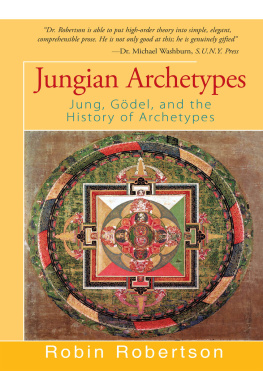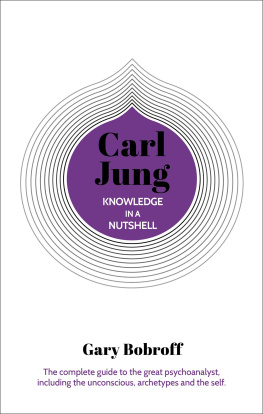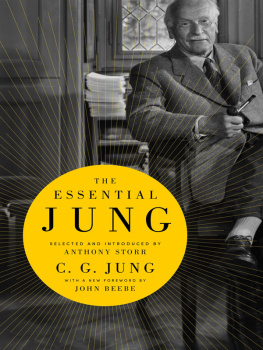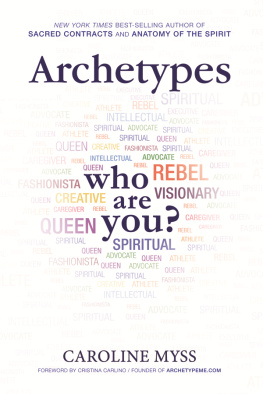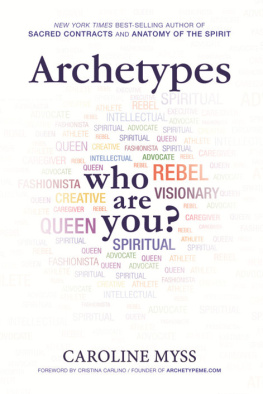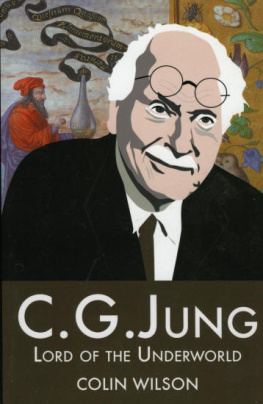Jungian Archetypes
Jung, Gdel, and the History of Archetypes
Robin Robertson
Praise for Jungian Archetypes
A patient once asked me What are all those science magazines doing in your waiting room? Real Jungian analysts, she believed, read only Parabola, Shamans Drum, or Modern Wicca. Its a safe bet that shes not likely to read this book. Too bad. If she did shed learn things about Jung that would pleasantly surprise her.
Jung was a scientist. Analysts are as well, although some dont realize it. Others, strangely enough, seem to want to deny it. But many of us love science, consider ourselves to be squarely in the scientific tradition, and stand in awe of its methods and discoveries. Robin Robertson writes for this latter group. He particularly enjoys mathematics, which, as the language of science, has its own paradoxes, contradictions, and metaphors.
In Jungian Archetypes: Jung, Gdel, and the History of Archetypes, he traces the history of science as expressed through mathematics. Robertsons book is a dialogue between the history of science and Jungian theory. His outline of the history of science is excellent. His review of Jung is equally adept. He writes clearly, simply, and completely he is very good at simplifying the complex.
John R. Van Eenwyk
Pacific Northwest Society of Jungian Analysts Excerpted from The Journal of Analytical Psychology, January, 1997
Jungian Archetypes is the most recent summation of [Robertsons] pioneering work in drawing together the scattered strings of historical thought on the possibilities and limitations of human consciousness. Step by step Robertson softly invites us to review once again the eternal questions of meaning and value that awakened our consciousness in youth and lead us on the numinous quests that hopefully continue to stir our endeavors in maturity. He makes the profoundly complex issues of Cantors Set Theory of Transfinite Numbers and Gdels Proof of the limitations of mathematical logicsurely esoterica for most ordinary mortalsopen and available to the literate reader. More, he convinces us of their relevance for our personal growth and the sense of meaning we seek in depth psychology. In this broadly appealing book, Robertson is doing something vastly more than simply explicating Jungian psychology: He is involved in sketching a plausible technical foundation for archetypal psychology in the coming millennium.
Ernest L. Rossi, Ph.D.
Psychological Perspectives, Issue 33, 1996
Robertson meticulously and effectively exposes the parallels between Jung the psychologist and Gdel the mathematician. His documentation of illustrated historical contributors to both fields is interesting and informing. In a direct style of writing, he has woven the development of abstract concepts and scientific research into a cohesive whole, showing that, at their root, psychology, philosophy, and science are different languages for the same understandings. For those who are skeptical and feel that science and psychology are antithetical to each other, Jungian Archetypes will provide proof to the contrary.
John Maerz
Starchild Books, Port Charlotte, FL New Age Retailer, October, 1996
Robin Robertson focuses on the quest for understanding the nature of hidden reality and especially on the roles that mathematics and psychology have played in that quest. It begins with a review of the foundations of both disciplines with their culmination in the works of Gdel and Jung. It ends with an appraisal of the limits to knowledge and with an expression of the need for a holistic union of mind with the unknowable aspects of the universe. These are invoked for the good of the individual, the intellectual enterprise, and humanity. I will claim that it also has relevance in posing a challenge to our discipline of dynamics and complexity. The book is exceptionally well crafted and clearly written.
Fred Abraham
The Blueberry Brain Institute Society for Chaos Theory in Psychology and Life Sciences Newsletter JanuaryMarch, 1996, Vol. 3, No. 3
I LLUSTRATIONS
To Lore Zeller, who has been so kind
to so many of us in Jungian psychology.
And to my late friend Gail Duke,
who always asked me to write more about mathematics.

P YTHAGORAS
P REFACE
Most of what is greatest in man is called forth in response to the thwarting of his hopes by immutable natural obstacles; by the pretence of omnipotence, he becomes trivial and a little absurd.
Twenty-five hundred years ago, the nearly mythical Greek mathematician Pythagoras [570500 B.C. ] founded a school of philosophy and mysticism on the premise that all is number, i.e., all reality is based on manifestations of the simple counting numbers. This doctrine was shaken by the discovery that the square root of 2 could not be expressed as a simple ratio of counting numbers. This discovery was so terrifying to the followers of Pythagoras that it could only be revealed to adepts who had already passed deeply into the mysteries of reality.
A century-and-a-half later, the Greek mathematician and philosopher Plato [428348 B.C. ] argued that behind the appearances of outer reality lies a deeper, truer world: the world of ideas (or ideals as they have been termed since the 18th century) of which physical reality is but a poor copy. We are like people living in a cave, unaware of the wide world without. We live our lives always facing the rear of the cave, content to watch shadows cast on the wall, discussing them as if they were solid and real. In actuality, the real worldthe world of ideaslies behind us. All that we think real are merely shadows created as those ideas pass back and forth before the eternal fire that lies still further away from human perception.

P LATO
A combination of these ideas grew and developed in the academy founded by Plato in Athens in 385 B.C. , culminating in the philosophies of both St. Augustine [354430] and the great Neoplatonists: Plotinus [205270], Porphyry [232304], Iamblicus [270330], and Proclus [410485]. After the Christian emperor Justin closed the academy (which he consider irreligious) in A.D. 529, these ideas went underground during the thousand years of the Middle Ages, from the fifth to the 15th century. Though their history during this period is more problematic, these ideas never fully died, and continued to crop up throughout both the Eastern and Western worlds during the Middle Ages. For example, the ideas of Plato and Pythagoras were kept alive in the Eastern world by the esoteric Moslem traditions of the Sufis. In the West, the ideas were largely submerged, though Franciscan monks preserved St. Augustines philosophy. Philosophical idealism began to peek its head out again in the West late in the Middle Ages, due both to contact with Moslems during the years of bitter fighting of the Crusades, and through the inter-mixing of Moslem, Jewish and Christian scholars in Spain. One person affected by this doctrine who will appear later in this book is the 16th century physician and metaphysician, Paracelsus.
In this book, we will pick up the story during the Renaissance, a critical point in the history of human thought, when we first began to look out at the world and carefully observe and record what we saw. With this new emphasis on the practical details of the physical world, one couldnt ask for a more opposite approach to reality from that of Pythagoras and Plato. Yet sometimes it pays to take a new direction before we return to our roots. This first half of the book will trace how this new Renaissance ideal slowly evolved and transformed, going so far in this new direction that it came around the corner and arrived back where it had left Pythagoras and Plato.

